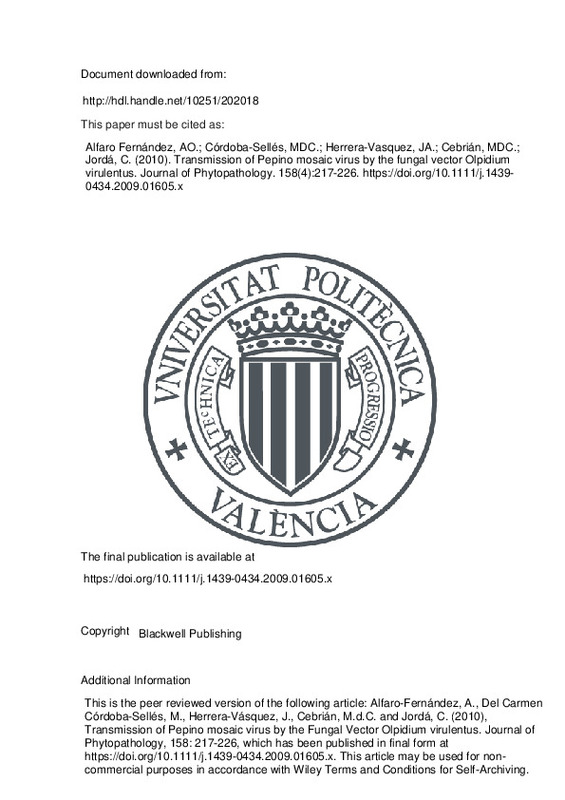Alfaro Fernández, AO.; Córdoba-Sellés, MDC.; Herrera-Vasquez, JA.; Cebrián, MDC.; Jordá, C. (2010). Transmission of Pepino mosaic virus by the fungal vector Olpidium virulentus. Journal of Phytopathology. 158(4):217-226. https://doi.org/10.1111/j.1439-0434.2009.01605.x
Por favor, use este identificador para citar o enlazar este ítem: http://hdl.handle.net/10251/202018
|
Título:
|
Transmission of Pepino mosaic virus by the fungal vector Olpidium virulentus
|
|
Autor:
|

 Alfaro Fernández, Ana Olvido
Córdoba-Sellés, Maria del Carmen
Herrera-Vasquez, Jose Angel
Cebrián, María del Carmen
Jordá, Concepción
Alfaro Fernández, Ana Olvido
Córdoba-Sellés, Maria del Carmen
Herrera-Vasquez, Jose Angel
Cebrián, María del Carmen
Jordá, Concepción
|
|
Entidad UPV:
|
Universitat Politècnica de València. Escuela Técnica Superior de Ingeniería Agronómica y del Medio Natural - Escola Tècnica Superior d'Enginyeria Agronòmica i del Medi Natural
|
|
Fecha difusión:
|
|
|
Resumen:
|
[EN] Transmission of Pepino mosaic virus (PepMV) by the fungal vector Olpidium virulentus was studied in two experiments. Two characterized cultures of the fungus were used as stock cultures for the assay: culture A was ...[+]
[EN] Transmission of Pepino mosaic virus (PepMV) by the fungal vector Olpidium virulentus was studied in two experiments. Two characterized cultures of the fungus were used as stock cultures for the assay: culture A was from lettuce roots collected in Castellon (Spain), and culture B was from tomato roots collected in Murcia (Spain). These fungal cultures were maintained in their original host and irrigated with sterile water. The drainage water collected from irrigating these stock cultures was used for watering PepMV-infected and non-infected tomato plants to constitute the acquisition-source plants of the assay, which were divided into six different plots: plants containing fungal culture A (non-infected and PepMV-infected); plants containing fungal culture B (non-infected and PepMV-infected); PepMV-infected plants without the fungus; and plants non-infected either with PepMV and the fungus. Thirty-six healthy plants grouped into six plots, which constituted the virus acquisition-transmission plants of the assay, were irrigated with different drainage waters obtained by watering the different plots of the acquisition-source plants. PepMV was only transmitted to plants irrigated with the drainage water collected from PepMV-infected plants whose roots contained the fungal culture B from tomato with a transmission rate of 8%. No infection was detected in plants irrigated with the drainage water collected from plots with only a fungus or virus infection. Both the virus and fungus were detected in water samples collected from the drainage water of the acquisition-source plants of the assay. These transmission assays demonstrated the possibility of PepMV transmission by O. virulentus collected from tomato crops.
[-]
|
|
Palabras clave:
|
Pepino mosaic virus
,
Virus transmission
,
Olpidium virulentus
,
Tomato
,
Potexvirus
|
|
Derechos de uso:
|
Reserva de todos los derechos
|
|
Fuente:
|
Journal of Phytopathology. (issn:
0931-1785
)
|
|
DOI:
|
10.1111/j.1439-0434.2009.01605.x
|
|
Editorial:
|
Blackwell Publishing
|
|
Versión del editor:
|
https://doi.org/10.1111/j.1439-0434.2009.01605.x
|
|
Código del Proyecto:
|
info:eu-repo/grantAgreement/MEC//AGL2005-06682-C03-01/
|
|
Descripción:
|
This is the peer reviewed version of the following article: Alfaro-Fernández, A., Del Carmen Córdoba-Sellés, M., Herrera-Vásquez, J., Cebrián, M.d.C. and Jordá, C. (2010), Transmission of Pepino mosaic virus by the Fungal Vector Olpidium virulentus. Journal of Phytopathology, 158: 217-226, which has been published in final form at https://doi.org/10.1111/j.1439-0434.2009.01605.x. This article may be used for non-commercial purposes in accordance with Wiley Terms and Conditions for Self-Archiving.
|
|
Agradecimientos:
|
This work was supported by Grant AGL2005-06682-C03-01 from the Spanish Ministry of Education and Science (MEC, Spain). We also thank Instituto Agroforestal Mediterraneo (UPV, Valencia) for fellowship support to A. ...[+]
This work was supported by Grant AGL2005-06682-C03-01 from the Spanish Ministry of Education and Science (MEC, Spain). We also thank Instituto Agroforestal Mediterraneo (UPV, Valencia) for fellowship support to A. Alfaro-Fernandez.
[-]
|
|
Tipo:
|
Artículo
|







![[Cerrado]](/themes/UPV/images/candado.png)


